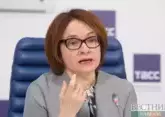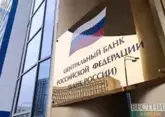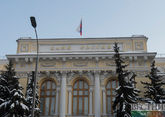The Board of Directors of the Russian Central Bank decided to keep the key rate at 7.25% per annum, based on the results of its meeting today.
"Annual inflation remains low. The April weakening in the ruble against the backdrop of geopolitical tension will be a factor for consumer price growth paces to quicken as they move closer to 4%. However, this does not create risks of inflation overshooting the target. At the same time uncertainty remains over the potential impact of the recent developments on inflation expectations. Inflation is forecast to range between 3-4% as of the end of 2018 and hold close to 4% in 2019," the regulator said.
The Central Bank also said that inflation in Russia is expected to range between 3-4% as of the end of 2018 and hold close to 4% in 2019.
"The Bank of Russia estimates that the ruble weakening will quicken inflation movement to 4% without the risks of overpassing this level, unless the external environment changes considerably. Inflation is forecast to range between 3-4% as of the end of 2018 and hold close to 4% in 2019," the regulator said.
Overall, inflation remains low, the Bank of Russia added. "Consumer prices grew at the pace of 2.4% in March, and consumer price growth in April is estimated at 2.3-2.5%," the Bank of Russia said.
The Bank of Russia notes growth of inflation risks due to external and internal factors, including geopolitical ones. "The Bank of Russia registers a rise in inflation risks triggered by some internal and external factors. First, geopolitical factors and accelerated yield growth in advances economies may cause surges in volatility in financial markets and affect expectations for the exchange rate and inflation. Furthermore, uncertainty still persists over the dimensions of fiscal decisions, which are needed to estimate the impact of such decisions on inflation," the Central Bank says.
The potential for the Central Bank’s key rate reduction has shrank, while the estimated neutral interest rate has shifted close to the upper bound within the 6-7% range, the Central Bank said.
The next meeting of the Board of Directors of the Russian Central Bank in 2018 is scheduled for June 15.
The head of the department of stock markets and financial engineering of the Faculty of Finance and the Banking Business of RANEPA, Konstantin Korischenko, speaking with Vestnik Kavkaza, explained why the Central Bank paused key rate cuts.
According to him, keeping the rate at the current level was due to the fact that the Bank of Russia, in addition to the inflation target, "also has secondary goals - stability of the ruble and overall stability of the Russian financial system, which is currently under sanctions." "Therefore, solving its first task of fighting inflation, the Central Bank is taking actions to protect the Russian economy. Unfortunately, the price is low growth rates," the expert explained.
At the same time, he expressed doubt that if these frightening factors remain in place, the Central Bank will raise the key rate in the future. "I think raising the key rate won't be the case. Another question is that the rate of its decline is stalled," Konstantin Korishchenko summed up.
Professor of the RANEPA faculty of Finance, Money Circulation and Credit, Yuri Yudenkov, in turn, noted that now it would be more logical to reduce the key rate by 0.25%. "This would not affect the market, but demonstrate to everyone that the Central Bank is confident in the future," the expert explained.
In his opinion, the decision to maintain the rate may be due to the fact that the Russian government will be changed soon.
In addition, Yudenkov pointed out that this situation indicates that the Bank of Russia has no clear course. "US sanctions were complete surprise for them, as well as what is happening on the stock exchange ... The Central Bank does not take any countermeasures and offers nothing to the economy to get out of this stalemate," Professor of the RANEPA faculty of Finance, Money Circulation and Credit concluded.










